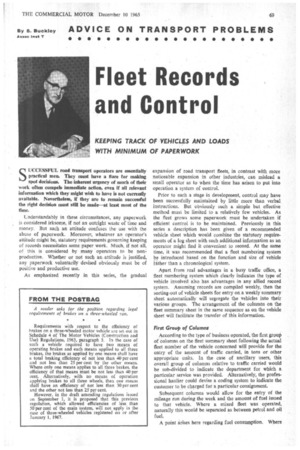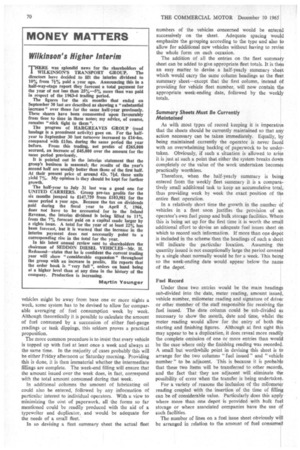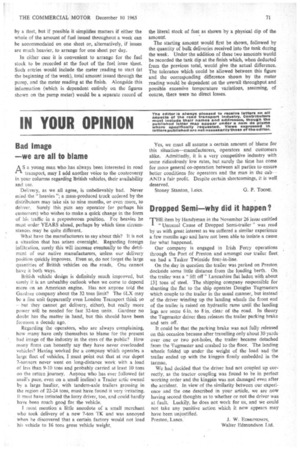Fleet Records and Control
Page 71

Page 72

Page 73

If you've noticed an error in this article please click here to report it so we can fix it.
SUCCESSFUL road transport operators are essentially practical men. They must have a flare for making spot decisions. The inherent urgency of much of their work often compels immediate action, even if all relevant information which they might wish to have is not currently available. Nevertheless, if they are to remain successful the right decision must still be made—at least most of the time.
Understandably in these circumstances, any paperwork is considered irksome, if not an outright waste of time and money. But such an attitude confuses the use with the abuse of paperwork. Moreover, whatever an operator's attitude might be, statutory requirements governing keeping of records necessitates some paper work. Much, if not all, of this is considered by many operators to be nonproductive. Whether or not such an attitude is justified, any paperwork voluntarily devised obviously must be of positive and productive use.
As emphasized recently in this series, the gradual expansion of road transport fleets, in contrast with more noticeable expansion in other industries, can mislead a small operator as to when the time has arisen to put into operation a system of control.
Prior to such a stage in development, control may have been successfully maintained by little more than verbal instructions. But obviously such a simple but effective method must be limited to a relatively few vehicles. As the fleet grows some paperwork must be undertaken if efficient control is to be maintained. Previously in this series a description has been given of a recommended vehicle sheet which would combine the statutory requirements of a log sheet with such additional information as an operator might find it convenient to record. At the same time, it was recommended that a fleet numbering system be introduced based on the function and size of vehicle father than a chronological system.
Apart from real advantages in a busy traffic office, a fleet numbering system which clearly indicates the type of vehicle involved also has advantages in any allied record system. Assuming records are compiled weekly, then the sorting-out of vehicle sheets for entry on a weekly summary sheet automatically will segregate the vehicles into their various groups. The arrangement of the columns on the fleet summary sheet in the same sequence as on the vehicle sheet will facilitate the transfer of this information.
First Group of Columns According to the type of business operated, the first group of columns on the fleet summary sheet following the actual fleet number of the vehicle concerned will provide for the entry of the amount of traffic carried, in tons or other appropriate units. In the case of ancillary users, this overall group of columns relative to traffic carried would be sub-divided to indicate the department for which a particular service was provided. Alternatively, the professional haulier could devise a coding system to indicate the customer to be charged for a particular consignment.
Subsequent columns would allow for the entry of the mileage run during the week and the amount of fuel issued to that vehicle. Where a mixed fleet was operated, naturally this would be separated as between petrol and oil fuel.
A point arises here regarding fuel consumption. Where vehicles might be away from base one or more nights a week, some system has to be devised to allow for comparable averaging of fuel consumption week by week. Although theoretically it is possible to calculate the amount of fuel consumed by a succession of either fuel-gauge readings or tank dippings, this seldom proves a practical proposition.
The more common procedure is to insist that every vehicle is topped up with fuel at least once a week and always at the same time. In the majority of cases probably this will be either Friday afternoon or Saturday morning. Providing this is done, it is then immaterial whether the intermediate fillings are complete. The week-end filling will ensure that the amount issued over the week does, in fact, correspond with the total amount consumed during that week.
In additional columns the amount of lubricating oil could also be entered, followed by any information of particular interest to individual operators. With a view to minimizing the cost of paperwork, all the forms so far mentioned could be readily produced with the aid of a typewriter and duplicator, and would be adequate for the needs of a small fleet.
In so devising a fleet summary sheet the actual fleet numbers of the vehicles concerned would be enter successively on the sheet. Adequate spacing wo emphasize the grouping according to the type and also allow for additional new vehicles without having to revi the whole form on each occasion.
The addition of all the entries on the fleet sum ma sheet can be added to give appropriate fleet totals. It is th an easy matter to devise a half-yearly summary sh which would carry the same column headings as the ft t summary sheet—except that the first column, instead f providing for vehicle fleet number, will now contain e appropriate week-ending date, followed by the wee y totals.
Summary Sheets Must Be Currently Maintained As with most types of record keeping it is imperati e that the sheets should be currently maintained so that a action necessary can be taken immediately. Equally, being maintained currently the operator is never face with an overwhelming backlog of paperwork to be unde taken. Obviously, if such a situation is allowed to ari e it is just at such a point that either the system breaks do completely or the value of the work undertaken becom s practically worthless.
Therefore, when the half-yearly summary is be g entered from the weekly fleet summary it is a compa tively small additional task to keep an accumulative to thus providing week by week the exact position of t e entire fleet operation.
In a relatively short time the growth in the number f vehicles in a fleet soon justifies the provision of operator's own fuel pump and bulk storage facilities. Whe e this is being set up for the first time it is worth the sm I additional effort to devise an adequate fuel issues sheet which to record such information. If more than one de t is included in the scheme then the headings of such a sh t will indicate the particular location. Assuming t e quantity issued is not exceptionally large the period cover by a single sheet normally would be for a week. This bei so the week-ending date would appear below the na of the depot.
Fuel Record
Under these two entries would be the main headings sub-divided into the date, meter reading, amount issu vehicle number, milometer reading and signature of driv r or other member of the staff responsible for receiving t e fuel issued. The date column could be sub-divided s necessary to show the month, date and time, whilst t e meter reading would allow for the entry of both t starting and finishing figures. Although at first sight th may appear to be a duplication, it does reveal more read' the complete omission of one or more entries than woul be the case where only the finishing reading was record A small but worthwhile point in devising this sheet is t arrange for the two columns "fuel issued" and " vehic number" to be adjacent. This is because it is probab that these two items will be transferred to other record and the fact that they are adjacent will eliminate t possibility of error when the transfer is being undertake
For a variety of reasons the inclusion of the milomet reading coupled with the insertion of the time of filli can be of considerable value. Particularly does this app where more than one depot is provided with bulk fu 'l storage or where associated companies have the use f such facilities.
The number of lines on a fuel issue sheet obviously be arranged in relation to the amount of fuel consum
by a fleet, but if possible it simplifies matters if either the whole of the amount of fuel issued throughout a week can be accommodated on one sheet or, alternatively, if issues are much heavier, to arrange for one sheet per day.
In either case it is convenient to arrange for the fuel stock to be recorded at the foot of the fuel issue sheet. Such entries would include the meter reading to start (at the beginning of the week), total amount issued through the pump, and the meter reading at the finish. Alongside this information (which is dependent entirely on the figures shown on the pump meter) would be a separate record of the literal stock of fuel as shown by a physical dip of the amount.
The starting amount would first be shown, followed by the quantity of bulk deliveries received into the tank during the week. Under the addition of these two amounts would be recorded the tank dip at the finish which, when deducted from the previous total, would give the actual difference. The tolerance which could be allowed between this figure and the corresponding difference shown by the meter reading would be dependent on the overall throughput and possible excessive temperature variations, assuming, of course, there were no direct losses.




























































































































